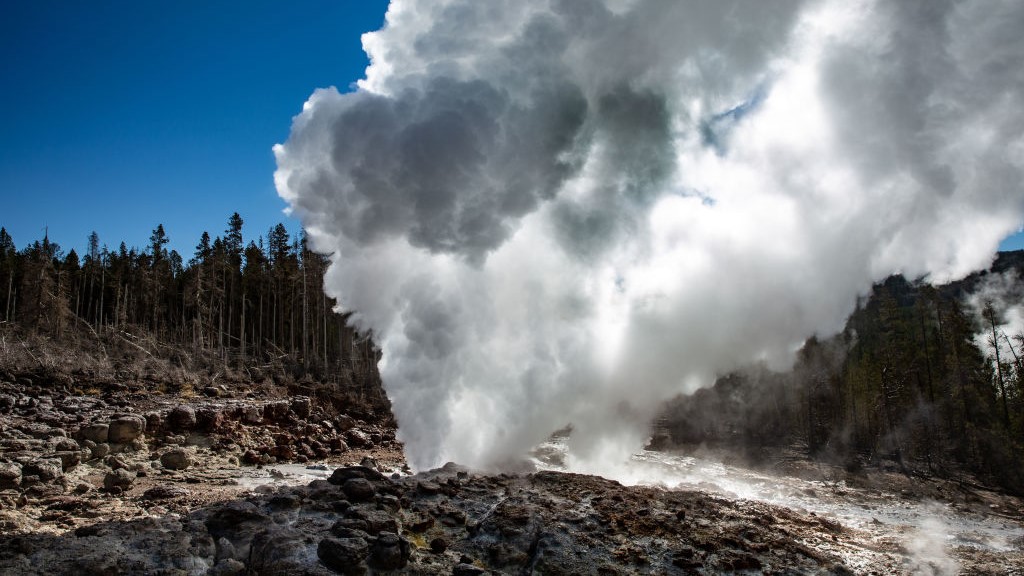Yellowstone's geysers at risk of extinction from climate change, tree skeletons reveal
In a warmer and drier climate, the groundwater that fuels Yellowstone's tallest active geyser could dwindle, resulting in less frequent eruptions and even extinction.
Yellowstone's Steamboat Geyser — the tallest active geyser on Earth — could fall victim to climate change and stop erupting as drought takes hold over the region, scientists say.
As temperatures soar and rainfall declines across the American West, the groundwater reserves beneath the national park could become insufficient to feed the iconic geyser, a new study has found.
"Groundwater is fuel for geysers," Michael Poland, a research geophysicist and scientist-in-charge at the Yellowstone Volcano Observatory, who was not involved in the new research, told Live Science in an email. "Without water, there's nothing for the geysers to erupt."
Unlike Yellowstone's Old Faithful geyser, which currently blasts 20 times a day, Steamboat does not erupt on a predictable schedule and experiences dry spells that can last between three days and 50 years.
To determine what causes these dry spells, researchers searched for clues in the trees that grow around the geyser vent.
Related: New mud-slinging thermal feature at Yellowstone is spewing scalding hot muck
When Steamboat erupts frequently, its spray coats the surrounding greenery in a thin layer of silica — a mineral found in the volcanic rocks that form geysers. The silica showers chokes trees that grow within 100 feet (30 meters) of the vent, providing a reliable record of Steamboat's past activity, researchers wrote in a study published Tuesday (July 25) in the journal Geochemistry, Geophysics, Geosystems.
Get the world’s most fascinating discoveries delivered straight to your inbox.
"Water that is erupting from the geyser is silica-rich, and when silica precipitates it clogs pathways that allow the trees to respire, photosynthesize and grow," study lead author Shaul Hurwitz, a research hydrologist with the U.S Geological Survey, said in a statement.
The spray kills nearby trees and creates a protective barrier against bacteria and fungi that would otherwise decompose the wood, Hurwitz said. Trees at Yellowstone don't tend to survive beyond 300 years, he added, but the geyser's blasts can preserve their wooden structures for centuries.
The dead, wooden structures that grew near the vent therefore embody time intervals when Steamboat did not erupt. When eruptions resumed, the silica-rich spray smothered and killed the trees. The researchers radiocarbon-dated tree skeletons that were within 46 feet (14 m) of the vent and detected three periods of growth — in the late 15th century, mid 17th century and late 18th century. They then matched these periods with regional climate records and found that Steamboat's dry spells coincided with periods of drought.
"Even small changes in precipitation could affect the interval between eruptions," Hurwitz said. "More water means more frequent eruptions, while less water means less frequent eruptions."
The idea that drought may cause water shortages and starve geysers is not new, Poland said. Research published in 2020 in the journal Geophysical Research Letters suggested a severe drought in the 13th century may have shut down Yellowstone's Old Faithful for several decades.
Changing weather patterns and temperature extremes linked to climate change could exacerbate these effects, Hurwitz said. "We might expect to see the geysers go to totally different behavior in terms of the interval between their eruptions — erupting less frequently, and some of them might even go extinct," he said.
But like Old Faithful, geysers that switch off when times are tough can spring back to life, Poland said. "Geysers are incredibly dynamic systems, and change all the time, so there's always a chance that a geyser will die off or a new geyser will form as the hydrothermal plumbing system in the shallow subsurface evolves."

Sascha is a U.K.-based staff writer at Live Science. She holds a bachelor’s degree in biology from the University of Southampton in England and a master’s degree in science communication from Imperial College London. Her work has appeared in The Guardian and the health website Zoe. Besides writing, she enjoys playing tennis, bread-making and browsing second-hand shops for hidden gems.




